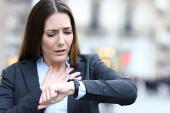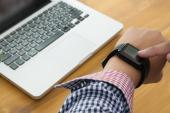Wearable Devices Are Cost-effective AF Screening Tools
For high-risk people 65 and up, wrist-worn technologies like smartwatches are a solid starting point, modeling data suggest.

Wrist-worn devices like smartwatches and fitness trackers appear to be cost-effective ways of screening for atrial fibrillation (AF) among high-risk people ages 65 and up, according to results of a new modeling study.
Nearly all screening strategies were an improvement upon not screening at all. This was true not only for the wearable tech, where concerns have been raised about the potential for greater consumption of healthcare resources, but also for the more-traditional pulse palpation and 12-lead ECG.
Yet the best strategy—with an incremental cost-effectiveness ratio of $57,894 per quality-adjusted life-year (QALY), below the acceptability threshold of $100,000—involved wrist-worn wearables equipped with both photoplethysmography (PPG), which uses light to detect an irregular pulse, as well as a single-lead ECG. With this approach, the device-provided information was confirmed by the patient using a wearable electrocardiographic monitor for a 2-week period.
“This essentially means that, in this strategy, the device is doing the initial screening for atrial fibrillation on the user in the background,” said Steven A. Lubitz, MD, MPH, senior author of the paper alongside Jagpreet Chhatwal, PhD (both Massachusetts General Hospital, Boston).
“The findings,” Lubitz told TCTMD in an email, “provide evidence that physician or healthcare system-directed use of wearable devices may be an important public health strategy to consider.”
For cardiologists, it’s time to “become familiar with the literature and understand how wearable devices are capable of detecting atrial fibrillation,” said Lubitz, adding, “Clearly, algorithms from wearable technology can detect irregular heart rhythms, and very often these irregular rhythms are indeed confirmed to be atrial fibrillation.”
The best candidates, he advised, are older patients at high risk of stroke who, if AF is diagnosed, stand to benefit from anticoagulation. One important caveat for now is that “the cost of these wearable devices is incurred by the patient, which can be prohibitive for many people and could therefore theoretically exacerbate healthcare disparities,” said Lubitz. “In the future, if payers cover the costs of wearable devices for detecting atrial fibrillation, we think it may be reasonable to consider prescribing these devices.”
With first authors Wanyi Chen, PhD, and Shaan Khurshid, MD, MPH (both Massachusetts General Hospital), the results were published recently in JAMA Health Forum.
First Wrist, Then Confirmation
The modeling study involved 30 million simulated people matched by age, sex, and comorbidities to the US population 65 years and older. Mean age was 72.5 years, and half were women. “All individuals in our simulation had a high enough risk of stroke such that anticoagulation would be indicated if a diagnosis of atrial fibrillation was made,” Lubitz noted to TCTMD.
Evidence and professional societies need to step in and establish sensible best practices that cardiologists can enact. Steven A. Lubitz
The researchers compared eight screening strategies—six based on wrist-worn wearable devices (watch or band PPG, with or without watch or band one-lead ECG) and two using traditional modalities (pulse palpation and 12-lead ECG)—against no screening.
Compared with no screening, all six of the wrist wearables were more effective: the estimated QALYs ranged from 226 to 957 per 100,000 people. The traditional approaches to screening were less effective, ranging from 116 QALYs lost to 93 QALYs gained per 100,000 people.
With the wrist devices, stroke incidence decreased by 20 to 23 cases per 100,000 person-years but major bleeding increased by 20 to 44 cases per 100,000 person-years.
“The use of wrist-worn wearable devices over years may facilitate an extended duration of screening, which may lead to detection of infrequent paroxysmal AF that may be otherwise difficult to ascertain,” the authors point out. “At the same time, the use of patch-monitor confirmation of abnormal signals from wrist-worn wearable devices reduced false positives.”
With the preferred strategy of PPG plus ECG followed by patch, the false-positive rate was 0.4%. This approach was consistently cost-effective irrespective of sex, age (eg, 50 years and up rather than 65 and up), and mean daily time the devices were worn (24 vs 6 hours).
Still, “pulse palpation and 12-lead ECG may be preferable in lower-resource settings,” as it consistently and affordably dominated over no screening, the authors suggest. Compared with no screening, this strategy saved $43 per person and offered 93 QALYs per 100,000 people.
From a Model to the Real World
Ioanna Kosmidou, MD, PhD (Memorial Sloan Kettering, New York, NY), commenting for TCTMD, said that in an ideal world it would be best to look at the cost-effectiveness question in a randomized trial, though this would require a prohibitively large sample size to achieve statistical power. In that light, a simulation model like this one “was certainly an interesting study to do,” she agreed. “In the end, this is probably one of the best approaches we can do given the circumstances.”
Wearable devices “are widely available and they are here to stay and we will have to deal with them,” said Kosmidou. For her, however, these results don’t undercut existing guidance for screening. “In clinical practice, [this] study will not move the needle too much, but as a hypothesis-generating study I think it’s interesting enough, because [its methods] subsequently can apply to different populations that are by definition at high risk.”
This, she said, should be the path forward. “We need to move towards identifying specific patient cohorts in which to look more [closely] at the value of screening,” suggested Kosmidou. “Arguably, [one] to start with would be the cancer patient population. Especially with novel therapeutics, a lot of patients develop cardiac arrhythmias or cardiac conduction [abnormalities], but mainly atrial fibrillation is what we see.” With a higher-risk population, a smaller trial would be easier to conduct, she explained.
Lubitz said that while their model was based on real-world costs and evidence, a “major unknown” is what the precise price of wearables would be. “For example, if a healthcare system or payer/insurance company contracted with a wearable device manufacturer, it is possible that a lower device cost would be negotiated. It is also possible that systems designed to address remotely collected data from wearables could cause healthcare systems to incur hidden costs, via new hires required to handle the data, other technological considerations related to data integration, etc,” he acknowledged.
Other challenges include the fact that healthcare systems remain ill equipped to handle all the newly available data as well as a lack of knowledge among clinicians about what the technologies are actually measuring and how they work.
Additionally, there’s uncertainty about the best sequence of tests to confirm AF after a device notifies its user, said Lubitz. For instance, “how should cardiologists counsel patients if atrial fibrillation is not confirmed using a medical grade monitor after a wrist-worn wearable detects an irregular rhythm? Evidence and professional societies need to step in and establish sensible best practices that cardiologists can enact.”
Caitlin E. Cox is News Editor of TCTMD and Associate Director, Editorial Content at the Cardiovascular Research Foundation. She produces the…
Read Full BioSources
Chen W, Khurshid S, Singer DE, et al. Cost-effectiveness of screening for atrial fibrillation using wearable devices. JAMA Health Forum. 2022;3(8):e222419.
Disclosures
- Chen, Khurshid, and Kosmidou report no relevant conflicts of interest.
- Lubitz reports receiving grants from Bristol Myers Squibb/Pfizer, Fitbit, IBM, Boehringer Ingelheim, Medtronic, Premier, the National Institutes of Health, and the American Heart Association as well as personal fees from Invitae, Blackstone Life Sciences, and Bristol Myers Squibb/Pfizer outside the submitted work. Though still affiliated with Massachusetts General Hospital and Harvard Medical School, he now works full time for Novartis.
- Chhatwal reports receiving personal fees from Bayer, Flatiron, and Value Analytics Labs as well as holding stock in Apple and Alphabet outside the submitted work.





Comments